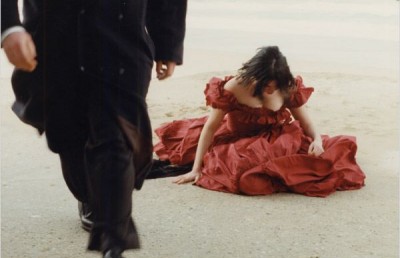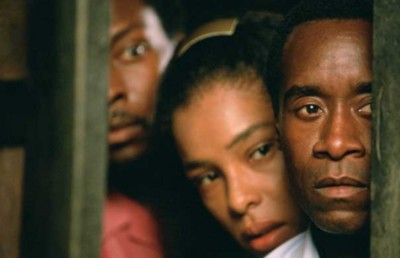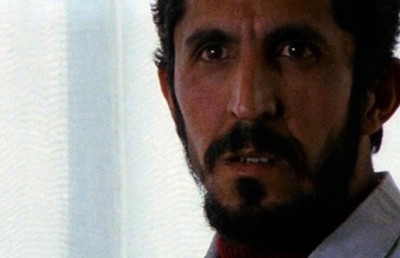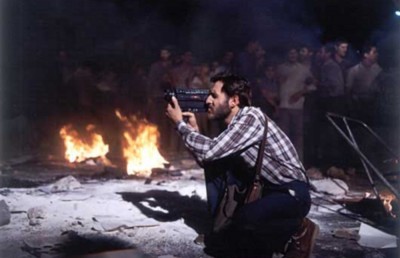Viewer Dissonance in Gerry
An Ecological Interpretation of Gerry
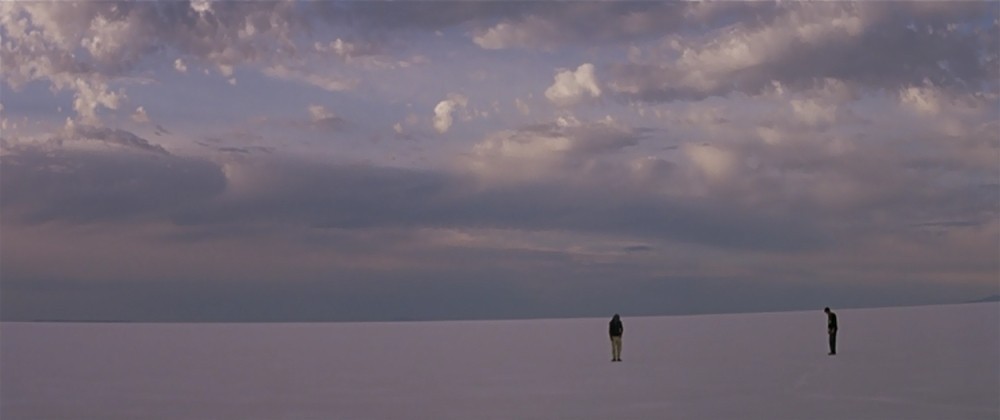
On an explicit level, Gerry (2002, Gus Van Sant) depicts two young men, both named Gerry, who become lost, and presumably die, in the American southwestern wilderness. While friends, there is some tension between them. On a more implicit level, in walking further away from a potential path back to society, they also travel backwards over the social, psychological, and biological development of humanity, with the contentious underpinnings of their friendship based on the evolutionary law that results in a survival of the fittest. In this sense, their movement away from civilization is both literal and metaphorical, spanning four days and millions of years. This implicit presentation of a regressive journey also applies to the natural environment, which throughout the course of the film undergoes a number of changes that are a mirror inversion of how nature gradually developed and changed over time.
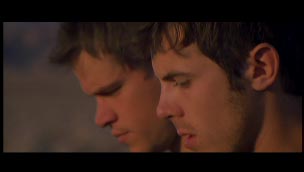
On a surface level, the banality of the characters creates viewer dissonance when contrasted with the seriousness of their life-threatening situation. The subtext of evolution, however, contests this relationship by suggesting that their death is, relative to this larger natural force, meaningless. These two views interact to create a secondary dissonance within the viewer. The tightly linked, unified way in which these two levels of meaning are organized in relation to each other is one of the film’s greatest strengths.
While perhaps not the best example of the traditional dramatic arch, Gerry does contain a point of crisis, after which the mental state of the two young men degenerates and the audience begins to loose whatever hope they might have harbored for their safe passage. Up until this point, the two men are relatively coherent and the film suggests a backward movement across cultural history. This idea is introduced by their arrival at a nature trail, a section of nature that has been tamed and made livable. Deciding they want to avoid sing alongs and camp groups they forge their own way, setting the stage for the backward motion. Having left this trail, Damon tells Affleck 1 about a recent “Wheel of Fortune” episode, which establishes a connection to the present, modern day world. That night Affleck recounts his computer game experience of conquering Thebes. His monologue deals with ancient Greek society, the raising of sheep, and a form of agrarian cultural organization that was the norm prior to the industrial revolution. When they begin to walk the following day, they decide to follow the tracks of presumably wild animals in the assumption that this will lead them to water. This idea, in which an approach to survival is first considered by an association with untamed animals, suggests a moment in history that predates the domestication of animals.
Slightly past the film’s midpoint, Damon and Affleck, hunched over a dirt map, become aware that they having been going the wrong way. This is the point at which their relationship begins to breakdown and the film’s regressive representation of human development shifts from the cultural to the psychological and biological. Human development can be viewed as an increasing ability to distinguish the real from the imagined. From the point of view of ontogeny, this would mean learning to differentiate fantasy from reality, and from a phylogenic perspective a movement from myth to more scientific explanations of natural phenomenon. Affleck’s conversation with a mirage of Damon indicates a psychological point of development that exists prior to this objectification. Damon similarly mistakes a mirage for water. Biologically, a connection is made between their exhausted, hunched posture and the physical body of the Neanderthal. This is most obviously expressed during the walking scene on the dawn of their final day. Suffering from dehydration and lack of nourishment, their walk is dehumanized and animalistic; the gradually increasing lighting suggests the dawn of humanity. Later that day, Afflect says “I’m leaving” and reaches for Damon. The two men then embrace and pull away. This division between their bodies, in addition to echoing the opening physical playfulness when they first get lost on the trail, also suggests the splitting of the cell, a biological necessity for the eventual development of humans.
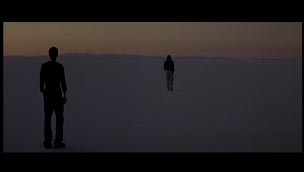
In addition to this presentation of human regression, the film also suggests the gradual evolution of the natural environment, primarily through a changing landscape and the use of the long take. When the boys first arrive at the nature trail, there is much vegetation that is approximately equal to them in height. As the film progresses, the amount of visible vegetation, on the whole, decreases, thus inversely mirroring the process by which vegetation gradually arose on earth. As they continue walking, the landscape becomes increasingly barren until the final moments, when they arrive at frozen, tundra-like ground, which suggests the ice age. In addition to this, long takes of the landscape are also used to suggest both the time span and process of change. The earliest of these moments occurs at dusk on their first night, when clouds are presented in time lapse photography. The sped up movement of the clouds indicates that the diegetic temporal duration is greater than the screen time of that representation. This principle comments on the backward progression across human history, which similarly presents a time span that far outstrips that of the diegetic story. In addition, the rolling clouds represent the dynamics of nature that is also responsible for the changes in natural history over time. Unlike the gradually changing vegetation, the long take and time lapse photography provides a sensory and somewhat disorientating experience of change. Part of what makes this effect so successful is that it works on multiple levels, establishing the length of time the two men are lost as well as this larger theme of natural change. The subtext is expressed in a way that is complimentary to the explicit content.
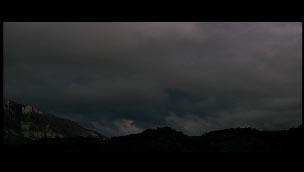
In terms of characterization, a contrast is made between the Gerrys which suggests the evolutionary law of natural selection, whereby certain members of a species gradually evolve and become stronger than the others, which are doomed for extinction. Affleck is shown to be the mental, physical, and intellectual inferior to Damon. Affleck has trouble understanding the humor of Damon’s anecdote about the wheel of fortune player who could not solve the puzzle, having to spell the word out loud. Affleck can barely tell his own simply story about conquering Thebes, while Damon questions certain details, correctly suggesting Affleck was trading horses and not sheep. Damon is usually seen to be walking ahead and can endure longer periods without thinking about water. A comparison of their body frames is all that is needed to know that Damon is the stronger of the two. Afflecks’ emotional fragility is revealed when he begins to cry at the top of the mountain, while Damon, who exhibits greater emotional control throughout, responds by asking him to stop crying.
The contentious underpinning of their relationship seems to be based on Damon’s perhaps unconscious awareness of this difference and the fatal impact it could, and does, have on his own life. By acquiescing to Afflecks’ desire to search for water, Damon abandons his superior idea of scouting the hilltops, and they become increasingly lost. This awareness that his chances for survival would be increased if he could free himself from Affleck is likely what motivates his initiations of temporary separations. Early in the film, he suggests they go separate ways and meet on a hilltop. On the hilltop, he suggests a second separation, adding bizarre instructions for reuniting and verbally confirming Affleck’s poor understanding of this muddled plan. That this effort was intended to ditch Affleck is further suggested by his obvious disappointment at finding him again, stranded on top of rock and in need of help to get down. He leaves Affleck in the final moments of the film. By this point it is too late. Damon’s awareness of this situation, if not its deeper connection to evolution, is also suggested during their first night at the campfire, when he says, “I hate you” to Affleck. This line might appear unmotivated, but in light of this conflict it is perhaps surprising that his hostility is not more overt.
This presentation of evolutionary forces interacts with other aspects of the film, creating viewer dissonance and confusion that is connected to the experiences of the two Gerrys. The explicit meaning –two boys lost in a desert– seems to waiver between the pointless and the significant, between long takes of simple walking and the pending inevitability of death. It is these two features that exist in opposition and create an unease in the viewer. However, the implicit meaning regarding the force of evolution interacts with this more apparent dichotomy in a way that contests its relation. The death of the Gerrys, in light of the larger evolutionary forces, becomes insignificant, with the status of importance shifted onto these larger natural forces. However, this does not constitute a true synthesis because the viewer, while accepting the omnipotence of nature, is unlikely to relinquish any attachment to the two men. The subtext of evolution gives rise to another form of viewer dissonance, based on the conflicting levels of importance that the film suggests be attributed to their death; the banality of their walk heightens its significance, while the presence of overwhelming natural forces renders it virtually meaningless. This creates a kind of viewer disorientation that is similar to that felt by the two Gerrys in the film, who have lost their bearings and are trapped in a physical and conceptual environment (i.e., the hallucinogenic POV shots).
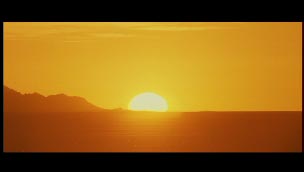
What is remarkable about Gerry is the unity and independence that the implicit ideas about evolution have in relation to the explicit banal situation of two young men who become lost and die. In some films the subtext does not interact with the artwork’s surface meaning, but rather stems out of it in order to comment on another situation. This is often the case with allegory. This approach risks undermining the work’s unity. If an artist wants to address a certain topic, they should do so in as direct a way as possible, without unnecessarily hiding behind obscure symbolism or removed circumstance. At the same time, the subtext regarding evolution, while interacting with the surface meaning to generate viewer dissonance, retains a certain independence and the superficial events do not rely on this subtext for their power. While it is fine (and desirable) to use ideological or theoretical frameworks to enhance a situation, a film that outright relies on these ideas for its power or clarity hardly deserves the title of art. In addition to this unity and independence, the presentation of implicit meaning within the film mirrors its reality outside the film. In both cases, the theme and reality of evolutionary forces is of great relevance but exists below the surface of our normal perception. In this way, the film’s subtextual presentation of natural forces becomes a kind of psychological realism, consistent with the use of long takes that also helps reinforce the film’s sense of believability. While the ideas raised in this essay hopefully have shed some light on how Gerry achieves its remarkable effect, what matters most is that it contains this remarkable power. At a time when Hollywood relies on special effects to woo the audience, it is refreshing to see a film like Gerry, a film in which time lapse photography of rolling clouds contains far more emotional impact that even the most expensive of explosions or car chases.
Notes
- Since both characters are called “Gerry,” the actor’s last names are used in this essay. ↩


